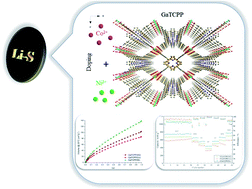Post-synthetically modified metal–porphyrin framework GaTCPP for carbon dioxide adsorption and energy storage in Li–S batteries†
Abstract
Lithium–sulphur batteries attract increasing interest due to their high theoretical specific capacity, advantageous economy, and “eco-friendliness”. In this study, a metal–organic framework (MOF) GaTCPP containing a porphyrinic base ligand was used as a conductive additive for sulphur. GaTCPP was synthesized, characterized, and post-synthetically modified by the transition metal ions (Co2+/Ni2+). The doping of GaTCPP ensured an increase in the carbon dioxide adsorption capacities, which were measured under different conditions. Post-synthetic modification of GaTCPP with Co2+/Ni2+ ions has been shown to increase carbon dioxide storage capacity from 22.8 wt% for unmodified material to 23.1 wt% and 26.5 wt% at 0 °C and 1 bar for Co2+ and Ni2+-doped analogues, respectively. As a conductive part of cathode material, MOFs displayed successful sulphur capture and encapsulation proven by stable charge/discharge cycle performances, high-capacity retention, and coulombic efficiency. The electrodes with pristine GaTCPP showed a discharge capacity of 699 mA h g−1 at 0.2C in the fiftieth cycle. However, the doping of GaTCPP by Ni2+ has a positive impact on the electrochemical properties, the capacity increased to 778 mA h g−1 in the fiftieth cycle at 0.2C.



 Please wait while we load your content...
Please wait while we load your content...